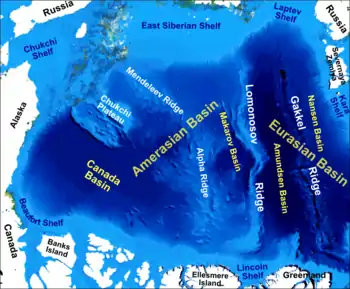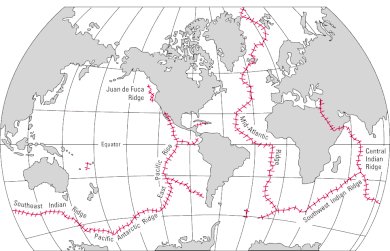Gakkel Ridge
The Gakkel Ridge (formerly known as the Nansen Cordillera and Arctic Mid-Ocean Ridge)[1] is a mid-oceanic ridge, a divergent tectonic plate boundary between the North American Plate and the Eurasian Plate.[2] It is located in the Eurasian Basin of the Arctic Ocean, between Greenland and Siberia, and has a length of about 1,800 kilometers. Geologically, it connects the northern end of the Mid-Atlantic Ridge with the Laptev Sea Rift.


The existence and approximate location of the Gakkel Ridge were predicted by Soviet polar explorer Yakov Yakovlevich Gakkel, and confirmed on Soviet expeditions in the Arctic around 1950. The Ridge is named after him, and the name was recognized in April 1987 by SCUFN (under that body's old name, the Sub-Committee on Geographical Names and Nomenclature of Ocean Bottom Features).[1]
The ridge is the slowest known spreading ridge on earth, with a rate of less than one centimeter per year. Until 1999, it was believed to be non-volcanic; that year, scientists operating from a nuclear submarine discovered active volcanoes along it. In 2001 two research icebreakers, the German Polarstern and the American Healy, with several groups of scientists, cruised to the Gakkel Ridge to explore it and collect petrological samples. Among other discoveries, this expedition found evidence of hydrothermal vents. In 2007, Woods Hole Oceanographic Institution conducted the "Arctic Gakkel Vents Expedition" (AGAVE), which made some unanticipated discoveries, including the unconsolidated fragmented pyroclastic volcanic deposits that cover the axial valley of the ridge (whose area is greater than 10 km2). These suggest volatile substances in concentrations ten times those in the magmas of normal mid-ocean ridges.[3] Using "free-swimming" robotic submersibles on the Gakkel ridge, the AGAVE expedition also discovered what they called "bizarre 'mats' of microbial communities containing a half dozen or more new species".[4]
The Gakkel ridge is remarkable in that is not offset by any transform faults. The ridge does have segments with variable orientation and varying degrees of volcanism: the Western Volcanic Zone From the Lena trough, 7° W, to 3° E longitude), the Sparsely Magmatic Zone (from 3° E to 29° E longitude), and the Eastern Magmatic Zone (from 29° E to 89°E).[5] The gaps of volcanic activity imply very cold crust and mantle, probably related to the very low spreading rate, but it is not yet known why some parts of the ridge are more magmatic than others.[6] Some earthquakes have been detected from the mantle, below the crust, which is very unusual for a mid-ocean ridge.[7] It confirms that the mantle and crust of Gakkel ridge, like some segments of the Southwest Indian Ridge, are very cold.
See also
References
- "IHO-IOC GEBCO Gazetteer" (PDF). International Hydrographic Organization/Intergovernmental Oceanographic Commission. September 2007. Archived from the original (PDF) on 2008-09-11. Retrieved 2008-05-24.
- "GPS Measurements Reveal Imprint of North American Plate in Siberia", Earth Institute at Columbia University, 2003
- Robert A. Sohn, et al., "Explosive volcanism on the ultraslow-spreading Gakkel ridge, Arctic Ocean", Nature 453, 1236-1238 (26 June 2008) | doi:10.1038/nature07075 http://www.nature.com/nature/journal/v453/n7199/full/nature07075.html (abstract)
- http://www.ridge2000.org/dls/abstracts.php Archived 2008-09-05 at the Wayback Machine "The Arctic Gakkel Vents (AGAVE) Expedition: A High–Stakes Technology Gamble Pays Big Dividends Beneath the Arctic Ice Cap", Ridge 2000 Abstracts 2009
- Peter J. Michael, et al., "Magmatic and amagmatic seafloor generation at the ultraslow-spreading Gakkel ridge, Arctic Ocean", Nature 423, 956–961, (26 June 2003) | doi:10.1038/nature01704
- Laurent Montesi and Mark D. Behn, "Mantle flow and melting underneath oblique and ultraslow mid‐ocean ridges", Geophysical Research Letters 34, L24307, ( 25 December 2007) | doi:10.1029/2007GL031067
- Vera Schlindwein, et al., "Seismicity of the Arctic mid-ocean Ridge system", Polar Science 9, 146-157, (March 2015) | doi:10.1016/j.polar.2014.10.001
Further reading
- Jokat, Wilfried, and Mechita C. Schmidt-Aursch. 2007. "Geophysical Characteristics of the Ultraslow Spreading Gakkel Ridge, Arctic Ocean". Geophysical Journal International. 168, no. 3: 983–998. doi:10.1111/j.1365-246X.2006.03278.x
External links
- Polar Discovery: Gakkel Ridge
- AMORE 2001: Arctic Ocean
- "No hole at the Pole," Geology News
- "Discovery of abundant hydrothermal venting on the ultraslow-spreading Gakkel ridge in the Arctic Ocean," Nature
- NOAA SCIENTIST AND COLLEAGUES FIND HOT SPRINGS IN COLD WATERS
- Scientists to explore Arctic Ocean ridge
